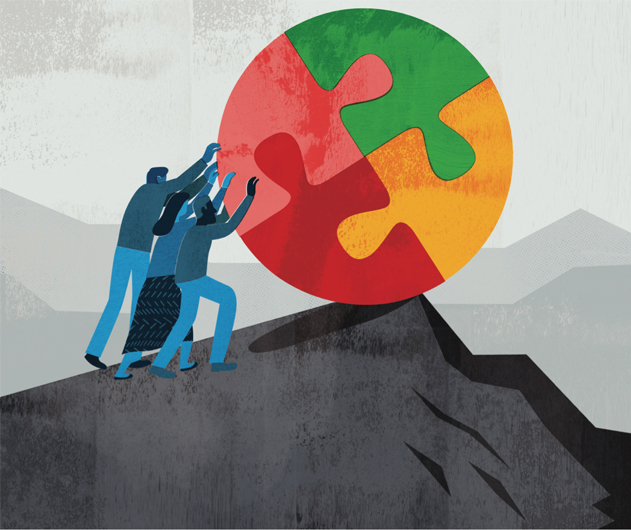By John Kania, Fay Hanleybrown, & Jennifer Splansky Juster
 People often ask whether we would refine the five conditions of collective impact that we articulated in the original article Collective Impact: common agenda, shared measurement, mutually reinforcing activities, continuous communication, and backbone support. While our work has reinforced the importance of these five conditions in achieving large scale change, we have found that there are also key mindset shifts that are necessary to be successful for collective impact.
People often ask whether we would refine the five conditions of collective impact that we articulated in the original article Collective Impact: common agenda, shared measurement, mutually reinforcing activities, continuous communication, and backbone support. While our work has reinforced the importance of these five conditions in achieving large scale change, we have found that there are also key mindset shifts that are necessary to be successful for collective impact.
MINDSET SHIFT ONE: WHO IS INVOLVED
The first core mindset shift is ensuring that an initiative gets all the right eyes on the problem. Complex problems cannot be solved by any single organization or sector alone. Yet many collaborations that seek to solve complex social and environmental problems still omit key partners in government and the nonprofit, corporate, and philanthropic sectors, as well as people with lived experience of the issue. Including the different perspectives of these diverse players can create a better understanding of the problem that is being addressed, as well as the potential solutions.
MINDSET SHIFT 2: HOW PEOPLE WORK TOGETHER
Collective impact is a structured process for collaborative problem-solving. For many, this is a fundamentally different way of working. In our recent article, Essential Mindset Shifts for Collective Impact, we highlight a few key shifts in how people work together:
- The relational is as important as the rational. – Using data and evidence to learn and improve are critical inputs for collective impact efforts, but strong relationships are equally critical. Lack of personal relationships, as well as the presence of strong egos and difficult historical relationships, can impede collective impact efforts. Collective impact practitioners must invest time in building strong interpersonal relationships and trust, which enable collective visioning and learning.
- Structure is as important as strategy. – When beginning a collective impact initiative, stakeholders are often tempted to focus on creating a “strategy”—a specific, tangible set of activities that they believe will ensure progress toward their goal. While it is important to have a sense of how partners will address a problem, collective impact practitioners must recognize that that the power of collective impact comes from enabling “collective seeing, learning, and doing,” rather following a linear plan. The structures that collective impact efforts create enable people to come together on a regular basis to look at data and learn from one another, and to understand what is working and what is not. Such interaction leads partners to adjust their actions, “doubling down” on effective strategies and allowing new solutions to emerge.
- Sharing credit is as important as taking credit. – One of the biggest barriers to collective impact that we have seen is the desire by individual organizations to seek and take credit for their work. Seeking to take direct credit is extremely difficult in large-scale collaborations, and can inhibit participants from making decisions that are aligned with the common agenda and hamper their efforts to create mutually reinforcing activities. This does not imply that organizations should not rigorously evaluate their own work and how it contributes to shared outcomes, but rather that organizations should think about their decisions in the context of others. Doing so also requires a behavior change among public and private funders, who can recognize an organization’s contribution toward the common agenda rather than seeking evidence of attribution of a grantee’s work.
MINDSET SHIFT THREE: HOW PROGRESS HAPPENS
Finally, there is an important mindset shift around the way progress happens through collective impact. In requires participants to:
- Pay attention to adaptive work, not just technical solutions. Collective impact initiatives are designed to help solve complex social and environmental problems, which by definition are unpredictable and constantly changing, and where no single person or organization has control. Such problems require adaptive problem solving. Collective impact allows for adaptive problem solving by pushing multiple organizations to look for resources and innovations to solve a common problem, enabling rapid learning through continuous feedback loops, and coordinating responses among participants.
- Look for silver buckshot instead of the silver bullet. Achieving population-level change requires stakeholders to abandon the search for a single silver bullet solution. Instead, they must shift their mindset and recognize that success comes from the combination of many interventions. For practitioners, this shift means thinking about their work as part of a larger context, and considering how their efforts fit into the larger puzzle of activities. Funders and policymakers similarly must shift from investing in individual, single-point interventions toward investing in processes and relationships that enable multiple organizations to work together. It is important to note that this shift toward silver buckshot solutions does not minimize the importance of high quality individual programs, interventions, and policies. Rather, it emphasizes that each of these programs and policies is necessary, but not sufficient, for success. Rather than isolating individual programs and trying to scale them up, collective impact works best when it focuses on the ways that strong individual interventions or policies fit together and reinforce each other to solve a complex problem.
In our work and research, we have seen that achieving results at scale using a collective impact approach requires the fundamental mindset shifts we have described here.
How have these mindset shifts played out in your work? We’d love to hear your reactions.
